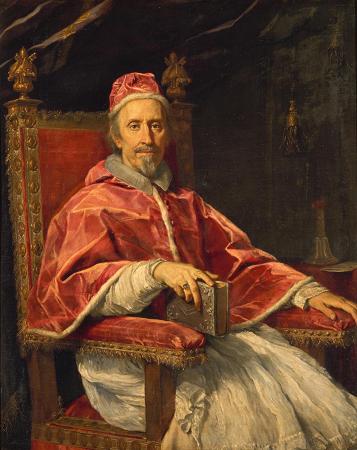Paolo Naldini (c1616 - c1681). Paolo Naldini was born in Rome on 10 June 1616, son Giovan Battista, sculptor, and of Virginia Mari. Around 1630 he began training and training under the guidance of the painter Andrea Sacchi, where he stayed for six years and met Carlo Maratta, with whom he formed a deep friendship and from whom he received a great influence, typically classicist and academic. Naldini's first work was the stucco decoration of the central nave of the Roman basilica of Santi Silvestro e Martino ai Monti, from 1649 to 1652 and in 1671, including twelve stucco statues of Saints and Martyrs, in academic style. The style of the stuccoes of the Roman basilica approached that of the classicist Alessandro Algardi, of whose works Naldini came to know in the workshop of his uncle Baldassarre, collaborator of both Gian Lorenzo Bernini and Algardi. Naldini was a national academic of San Luca from 1652 and from 1654 he was among the Virtuosi al Pantheon, the year in which he made a stucco Apollo for a fountain in Palazzo Cardelli, after which he executed the figure of San Prassede in the central nave of the basilica of Santa Maria del Popolo, designed by Bernini. Later he worked for the church of San Girolamo della Carità, between 1654 and 1656, where he made the valuable stucco medallions depicting San Francesco and San Bonaventura. Between 1659 and 1660 he was present in the construction site of the palace of Cardinal Marzio Ginetti in Velletri, for some stucco Caryatids, which have been lost. In 1661, after the death of the master Sacchi, he committed himself to the funeral monument, located in the basilica of San Giovanni in Laterano. In November 1663 he finished the stucco relief with San Guglielmo d'Aquitania, in the central nave of the church of San Nicola da Tolentino ; within the same year he worked on the de Sylva chapel in San Isidoro at Capo le Case, for the marble figures of Peace and Justice. Later he collaborated with Bernini, of whom he was a pupil and follower, in the Vatican. He participated in the decoration of the Scala Regia, where with Ercole Ferrata and Lazzaro Morelli he executed most of the stuccos; to the chair of San Pietro, where he worked in 1665, creating part of the stucco Angels of the Glory, and to the colonnade, for which, in 1666, he created two statues, Santa Tecla and Sant'Agnese. Around 1668 he painted the marble bust of Duke Filippo Caetani in the Caetani chapel in the basilica of Santa Pudenziana and between 1669 and 1671 he collaborated with other sculptors to create the ten marble Angels with the instruments of the Passion placed on the new parapet of Ponte Sant'Angelo designed by Bernini. In 1674 he completed the busts of Raphael and Annibale Carracci in the Pantheon.Between 1673 and 1675 he worked for the church of Santa Maria delle Grazie in Todi, with a statue of San Filippo Benizi and a Madonna in glory. In the seventies of the seventeenth century he worked for the bronze bust of Bartolomeo Ruspoli, for the marble bust of Gaspare Marcaccioni in the church of Santa Maria del Suffragio, for that of the Englishman James Alban Gibbes, in the first chapel on the right in the Pantheon; before 1679 he completed the vibrant stucco Putti above the doors of the Vivaldi chapel in the basilica of Santa Maria in Montesanto. In 1686 he completed the two stucco Angels that support the terrestrial globe placed on the tympanum of the main altar of the church of Gesù e Maria al Corso. In the last decade of his life, he married on May 20, 1681 with Barbara di Bartolomeo Tavarini and devoted himself to painting. Paolo Naldini died in Rome on February 7, 1691.
more...











